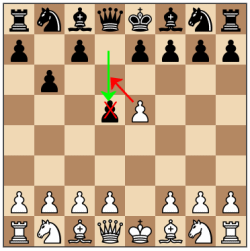

The general chess community's relative unfamiliarity with En Passant has turned "Google En Passant" into a catchphrase, particularly when a player is salty about losing to what they perceive is cheating.

The move began making its way into memes when staff members of posted a humorous editorial explaining En Passant and lamenting the numerous reports they've received of players supposedly cheating or hacking by using the move. "En Passant" became a meme in the chess community in two ways. If Black chooses to not utilize En Passant on their turn, it's then off the table. This move can only be done on the turn following White's move forward two spaces. If all of these conditions are met, Black can capture the offending pawn by moving diagonally to the space the White pawn skipped.

White takes one of its pawns, in a column next to the Black pawn's, and moves it forward two spaces, seemingly straight past the space where the Black pawn could normally capture it. Let's say Black has moved its pawn forward three spaces. "En Passant" can only happen under a specific set of circumstances. This is called " En Passant," and it's been flabbergasting even some veteran chess players for years. However, there's another, third way a pawn can move in a scenario so situational, it's practically a secret, and when it does occur, it looks like cheating. The only way a pawn can capture another piece is if that piece is diagonally in front of it. Pawns can only move forward one space at a time, or two if it's the first time they've moved in the game. Though it’s relatively rare in practice, the en passant rule is important to know.īut as with any move in chess, it’s important to evaluate your entire position.Įn passant can be a great way to advance a pawn you plan to promote, but if that same pawn secures your position, moving it could cause your whole position to collapse.Anyone with a basic knowledge of chess can tell you how pawns move. The en passant move can only be made on the move immediately after the enemy pawn makes the double-step move otherwise, the right to capture it en passant is lost. The capture can only be made on the move immediately after the enemy pawn makes the double-step move otherwise, the right to capture it en passant is lost.The pawn that will be captured must have just moved two squares in a single move.The pawn that will be captured must be adjacent to the capturer.The pawn that captures must be on its fifth rank.Official Rules/Conditions for an En Passant
#En passant rule how to#
Here is the most basic example of how to en passant.Įxample 2: As Black - When pawns are blocked The en passant rule is a way to keep things the same after pawns were allowed two move forward two squares during their first turn. Without the en passant rule, a lot of unfair situations would happen during chess endgames that wouldn’t have existed prior to the rule changes. The en passant special rule was added so pawns that these pawns could still be captured. This gave rise to the situation where a pawn could move two squares forward on its first move and avoid getting captured by the adjacent enemy pawns. See an example of how to en passant below:īefore, the rules changes in chess, pawns were only allowed to move one square at a time.īut during the 15th century, a rule change happened where pawns were allowed to move two squares forward on their first move. An en passant is a special move in chess.


 0 kommentar(er)
0 kommentar(er)
